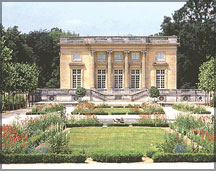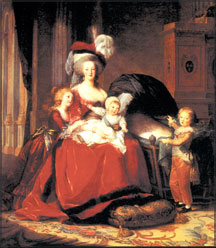|
DAILY NEWS ONLINE |
|
|
|
OTHER EDITIONS |
|
|
|
|
|
|
|
|
|
OTHER LINKS |
|
|
|
|
|
|
  |
|
|
|
|
On my recent visit of Versailles, I walked through the enormous, opulent palace and its splendid gardens laid out on 250 acres of land. Their sight touched my heartstrings, when reminiscing the tragic end of the royal family who lived there.
I least expected that the Versailles palace and its sprawling gardens were haunted. But from the very beginning of my visit to the uncanny Versailles, I was troubled by strange feelings of uneasiness and loneliness, there was an oppressively solemn atmosphere pervading all over the place.
Was I psychic? I never had such an experience, when I visited other royal places in Britain, Belgium and Austria. I found later that my feelings in Versailles were not unique to me. Several other visitors to Versailles in the past had recorded that they too experienced similar feelings - and much more.
Our story begins on 10 August, 1901, when Eleanor Guardian and Annie Moberly, both British scholars, were visiting the Palace of Versailles during a holiday stay in France.
|
|
After wandering through the Grand Trainon where the Age of Kings has been resplendently captured in time, the two friends began walking towards the Peti Trianon, a pre-Revolution architectural masterpiece situated away from the main palace, but with in the Versailles gardens.
This gorgeous mansion was a gift to Marie Antoinette by her husband, King Louis XVI in the year 1774, soon after their marriage, and she used it until the bloody Revolution ended the royal reign of the Bourbons for the next 25 years.
In their book, "An Adventure", the two British scholars recall, 'an extraordinary depression and a strange feeling inside the Versailles gardens'. When they arrived at the mansion of Petit Trianon, the air had turned deathly still. Not a leaf rustled. Then suddenly they encountered two 'men' dressed in 18th century costumes.
|
|
After getting directions form those 'men', the two women neared Petit Trianon, the former house of Marie Antoinette. They were horror-struck, when they saw a woman who was sitting pensively on a small seat on the grass. She too was dressed in authentic period costumes of the 18th century.
The bizarre experience, lasting for some 30 minutes, led both women to conclude that the Petit Trianon was haunted. They visited the site subsequently on several fact-finding missions, and each time found the same oppressive atmosphere that seemed to hover over the area.
One of the last recorded sightings came in May 1955, when a British lawyer and his wife walked toward the Petit Trianon. They too encountered people in period costumes of the 18th century. Like other apparitions over the decades, those figures too vanished into thin air.
|
|
Sightings like prompted much speculation about the exitance of ghosts and other phenomena at Versailles. Famed psychic researcher G.W. Lambert, who later wrote a book on the Versailles haunting, believes in their validity. Based on historical data, he feels that the two English women had somehow seen Versailles as it would have appeared in the 1770.
Some researchers are of the view that the melancholic woman, whom the two English women saw sitting on the grass, could have been an apparition of Marie Antoinette. Why is she haunting the place, after all?
Marie Antoinette was born in Austria. She was one of the 16 children of Maria Theresa, archduchess of Austria and Queen of Hungary and Bohemia, and Holy Roman Emperor Francis I. From 1774, she became the Queen of King Louis XVI of France.
Many French people hated the Queen for her Austrian blood and her formerly frivolous ways. She was rumoured to have had numerous, steamy love affairs with several men, in her married life.
Marie Antoinette was blamed for the country's financial problems, because she enjoyed a lavish lifestyle. As a woman and a foreigner she made a convenient scapegoat for the nation's problems and her irrepressible spending habits.
In 1789, the French Revolution erupted, plunging the starving, impoverished nation into an unprecedented catastrophe. Its causes were many, but much of the revolutionaries' fury focused on Marie Antoinette.
When the Bastille was stormed on July 14, 1789, the Queen urged the King to resist the Assembly's reforms, making her even more unpopular, and leading to the attribution to her of the remark, "Ou 'ils mangent de la brioche!" - "Let them eat cake! Imprisoned with the King, Marie Antoinette continued to plot, but of no avail. Ultimately, her unpopularity paved the way for the overthrow of the monarchy in 1792.
Because the King was apathetic, it fell to Marie Antoinette to negotiate with revolutionaries on the royal family's behalf. But her attempts bore no fruit, because she was opposed downright to reform. Consequently, the institution of royalty was officially abolished in France in 1792, and the royal family was moved to the Temple prison.
At the beginning they were treated fairly well and were permitted to live together. In December 1792, Louis's trial began. He was found guilty and sentenced to death, and on January 21, 1793 he went bravely to the guillotine, jeered and ridiculed by the violent mobs.
After Louis's death, his brother (the future Louis XVIII), who had escaped from France years earlier, proclaimed Marie Antoinette's son Louis Charles to be the new King of France. For several months after their father's death, Louis Charles and his sister, Marie Therese Charlotte, remained in prison with Marie Antoinette.
The children were often sick, and the Queen cared for them as best she could. Spitefully their jailors decided to separate young Charles Louis from his mother. He was placed in the cell beneath hers, where she could hear him crying.
A few weeks later Marie Antoinette was separated from her daughter, as well. The former Queen was awakened in the middle of the night and hurriedly taken to the squilid Conciergerie prison. Louis Charles and Marie Therese Charlotte remained in the Temple. They never saw their mother again.
In October 1793, Marie Antoinette, now called, "the Widow Carpet," was tried and, like her husband, convicted of treason and sentenced to be guillotined.
On October 16, 1793, she was taken through the streets of Paris in an open cart. She maintained her dignity to the end. On the scaffold she created a heart-rendering human drama.
In her nervousness in the throes of death, she accidentally stepped on the executioner's foot, prompting her to mouth her last words just split seconds before she was guillotined: "Monsieur, I ask your pardon. I did not do it on purpose."
Against all norms of human decency and religious precepts, the French revolutionists kept her hapless, sick son Louis Charles (now King Louis XVII) in a dark, filthy cell until he died of tuberculosis in 1795.
In future years there were many claiming to be the long-lost prince. The most believable was Karl Whilhelm Naundorft, who died in Holland in 1845, but DNA tests later established that Naundorff was not related to Marie Antoinette.
Moreover, DNA experts announced in April 2000 that tests conducted on the heart of the boy who died in prison proved once and for all that he was, in fact, Marie Antoinette's son. Marie Antoinette's daughter, Madame Royale, survived the revolution. She became the duchess d'Angouleme and lived to see the reigns of her uncles Louis XVIII and Charles X.
In the final analysis, the haunting of Versailles must be considered a puzzling mystery to this day.
(The article is written by the author and publisher of the book, "Alien Mysteries in Sri Lanka and Egypt, the new Version", which was launched recently.)
|
|




